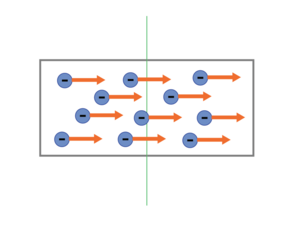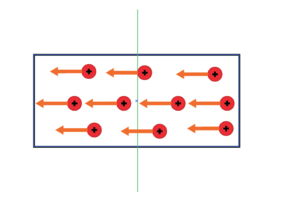Current
Claimed by spencer
Explanation of Current Through a Wire
The Main Idea
The electric current is the rate of flow of electric charge through an area. It is important to note that the charge in the circuits you will be dealing with are not in equilibrium, but instead, in the steady state. The distinction between equilibrium and the steady state is as follows. In equilibrium, a metal contains no mobile charges in motion (average drift velocity = 0). In the steady state, the particles may be moving however they please, but their average drift velocity stays constant.
Another important distinction to make is the difference between the electron current and the conventional current. The electron current is denoted by a lowercase i, describes the number of electrons per second to enter or leave a section of a conductor, and has units of electrons per second. The direction of the electron current is described as the direction the electrons inside a wire are moving. This is true in most cases since electrons, not protons, are the mobile charge carriers in circuits.

On the other hand, the conventional current is denoted by an uppercase I, describe the amount of charge that passes a cross-section of a wire per second, and therefore has units of coulombs per second, or amperes (abbreviated as A). Since the conventional current is described by a positive charge, the direction of the conventional current will be opposite to the direction of the electron current. If the mobile charges were positive, they would move in the direction of the conventional current.

Before scientists knew that electrons were the common charge carriers, they discovered current. And, with only two choices, they chose to treat the moving charges as positive. This may seem annoying at first, but there are some benefits to using the conventional current over the directly opposed "electron current". For one, it flows from the positive end of a battery toward the negative end, and from high to low energy.
A Mathematical Model
Assume uniform density [math]\displaystyle{ n }[/math] of mobile electrons (uniform current) moving with an average drift speed [math]\displaystyle{ v }[/math] in a wire of cross-sectional area [math]\displaystyle{ A }[/math]
[math]\displaystyle{ i=density⋅area⋅length/time = nAv }[/math]
with units of
[math]\displaystyle{ electrons/m^3⋅m^2⋅m/s=electrons/s }[/math]
Since I (conventional current) is defined as the amount of charge moving pass a point per second, we multiply the number of electrons by positive charge [math]\displaystyle{ |q| }[/math] to get:
[math]\displaystyle{ I = |q|⋅i = |q|nAv }[/math]
with units of
[math]\displaystyle{ coulombs⋅electrons/s = C/s = Ampere }[/math]
Another way to express the formulas for current is in terms of the electron mobility [math]\displaystyle{ μ }[/math]of the wire and the electric field [math]\displaystyle{ E }[/math] inside the metal. This can be done by recognizing that the average drift speed [math]\displaystyle{ v = μE }[/math]. Substituting this into the equations for electron and conventional current, we get:
[math]\displaystyle{ i = nAv = nAμE }[/math] (electron current)
and
[math]\displaystyle{ I = |q|nAv = |q|nAμE }[/math] (conventional current)
If a charge distribution of density [math]\displaystyle{ ρ }[/math] moves with the velocity [math]\displaystyle{ v }[/math], the charge per unit time through [math]\displaystyle{ ΔA }[/math] is [math]\displaystyle{ ρv⋅nΔA }[/math] [math]\displaystyle{ Δq=ρv⋅nΔAΔt }[/math]. [math]\displaystyle{ ρ = Nq }[/math]
The charge per unit time is then [math]\displaystyle{ ρv⋅nΔS }[/math], from which we get the current density to be [math]\displaystyle{ Nqv }[/math]
The current I through the surface is [math]\displaystyle{ I=∫Nqv⋅dA }[/math]
Other useful mathematical relationships of [math]\displaystyle{ I }[/math] in circuits are
[math]\displaystyle{ I = ΔV/R }[/math]
where [math]\displaystyle{ ΔV }[/math] is the potential difference and [math]\displaystyle{ R }[/math] is the resistance in ohms. and
[math]\displaystyle{ P = I⋅ΔV }[/math]
where [math]\displaystyle{ P }[/math] is the power of a circuit component.
In summary,
[math]\displaystyle{ i = nAv = nAμE }[/math] (electron current)
[math]\displaystyle{ I = |q|nAv = |q|nAμE }[/math] (conventional current)
[math]\displaystyle{ I = ΔV/R }[/math]
[math]\displaystyle{ P = I⋅ΔV }[/math]
Examples
Be sure to show all steps in your solution and include diagrams whenever possible
Simple
One type of problem you are sure to encounter involves a battery and resistor. You can read more about that section on the RC page of this wiki, but here's how to solve one now:
Using your formula sheet, notice that [math]\displaystyle{ I = {|ΔV|\over R} }[/math]. where R is the resistance in the circuit and |ΔV| is the voltage.
If you're given that the 50V battery is connected to a 100 [math]\displaystyle{ Ω }[/math] resistor, you simply substitute the values into your equation. [math]\displaystyle{ I = {50V\over 100 Ω} }[/math] [math]\displaystyle{ I = 0.5A }[/math]
Middling
Current will not always be what you solve for, though. In this problem, let's use the equations we've discussed to find the drift velocity [math]\displaystyle{ v }[/math]. Given the current is [math]\displaystyle{ 1A }[/math], the electron density is [math]\displaystyle{ 8 ⋅ 10^{27}m^{-3} }[/math], and the diameter of our wire is [math]\displaystyle{ 1mm }[/math].
Solution
First, let's find the area [math]\displaystyle{ {0.001\over 2}^{2}⋅π=7.85⋅10^{-7} }[/math]
Then, plug in the rest: [math]\displaystyle{ 1=|-1.6⋅10^{-19}|⋅5⋅10^{28}⋅7.85⋅10^{-7}⋅v, v = 9.9477.85⋅10^{-4}{m\over s} }[/math]
Difficult
The density of mobile electrons in aluminum metal is [math]\displaystyle{ 2.1 ⋅ 10^{29}m^{-3} }[/math]. You have a wire that is 20 cm long with a radius of 1.6 mm, and it takes 112.6 minutes for a single electron in the electron sea to drift from one end to the other. Given that the electron mobility of aluminum is [math]\displaystyle{ 0.0012 m^2/Vs }[/math], find the conventional current (I) and the electric field (E) in the wire.
Solution
First, find E. Since [math]\displaystyle{ v=μE, E = v/μ }[/math]. We can find [math]\displaystyle{ v }[/math] by realizing that [math]\displaystyle{ v=Δx/Δt }[/math]. [math]\displaystyle{ Δx = 0.20 m }[/math] and [math]\displaystyle{ Δt = 112.6 min = (112.6min)⋅(60 s/min) = 6756 s }[/math].
Then, [math]\displaystyle{ v=Δx/Δt = (0.20m) / (6756 s) = 2.96⋅10^{-5}m/s }[/math].
Therefore, [math]\displaystyle{ E = v/μ = ({2.96⋅10^{-5}m/s})/({0.0012 {m^2}/Vs}) = 0.0247 V/m }[/math]
Now, we can use [math]\displaystyle{ I = |q|nAv }[/math] to find the conventional current. Note that [math]\displaystyle{ A = πr^2 = π(0.0016)^2 = 8.04⋅10^{-6}m^2 }[/math] and [math]\displaystyle{ q= charge of electron = -1.6⋅10^{-19} C }[/math]
[math]\displaystyle{ I = |q|nAv = (1.6⋅10^{-19} C)⋅(2.1 ⋅ 10^{29}m^{-3})⋅(8.04⋅10^{-6}m^2)⋅(2.96⋅10^{-5}m/s)=8.00 A }[/math]
Connectedness
A current is something which exists is any circuit and affects many other attributes. For example, currents also create magnetic fields. A major application of current is in transformers, since transformers rely on inductance to convert the amount of current and potential difference while maintaining the same amount of power. Fields that deal directly with electricity and circuits, such as electrical and computer engineering may often find themselves dealing with currents.
History
A giant leap in our understanding of electric charge and current was advocated by Benjamin Franklin who tried many different experiments with charges. He was the first to coin the terms positive and negative charges. However, evidence and electric currents was not provided until around 1800 when batteries were invented and currents could be investigated further. Initially, scientists thought that charges and currents were different phenomena, but today we understand that currents are simply moving charges.
See also
Further readings
Chabay, Ruth W., and Bruce A. Sherwood. Matter & Interactions. N.p.: n.p., n.d. Print.
External Links
http://physics.info/electric-current/
http://hyperphysics.phy-astr.gsu.edu/hbase/electric/elecur.html
References
https://en.wikipedia.org/wiki/Electric_current
http://www.feynmanlectures.caltech.edu/II_13.html#Ch13-S2
http://hyperphysics.phy-astr.gsu.edu/hbase/electric/elecur.html
Chabay, Ruth W., and Bruce A. Sherwood. Matter & Interactions. N.p.: n.p., n.d. Print.
http://physics.info/electric-current/
http://practicalphysics.org/electric-charge-and-current-short-history.html